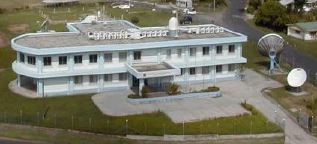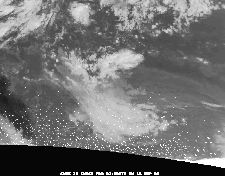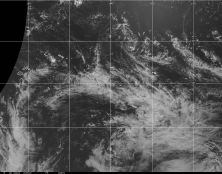
WMO/CAS/WWW
FIFTH INTERNATIONAL WORKSHOP ON TROPICAL CYCLONES
Topic 0.1b: PRESENT AND FUTURE USES OF SATELLITE OBSERVATIONS FOR TROPICAL CYCLONE FORECASTING AND RESEARCH
Presentor: A. Waqaicelua
Regional Specialised Meteorological Centre
Nadi-Tropical Cyclone Centre (RSMC Nadi-TCC)
Fiji Meteorological Service, Private Mail Bag NAP0351,
Nadi Airport, Republic of Fiji Islands.
E-mail: Alipate.Waqaicelua@met.gov.fj
Fax: 679.672.0430
Abstract
Satellite data have effectively filled the meteorological observational vacuum that naturally exists in the Southwest Pacific region. This is in the sense of filling the gaping spaces between observing stations rather than replacing synoptic observations. Weather satellites have also opened up opportunities for RSMC Nadi to effectively and with confidence monitor weather, issue timely and more objective forecasts, warnings and advisories to all the regional communities. Prior to the satellite era, forecasts, warnings and advisories were basically biased towards the traditional and primitive methods, which were based on real-life experiences our forefathers had through the years of living and surviving in their maritime environment. Some of these methods became useful forecasting tools in Nadi during tropical cyclone events, as they proved effective. However, the critical component of the warning system, which is timely dissemination of warnings to communities under threat was often compromised, as there was no appropriate way of relating the “unseen” phenomena and its real effects, which the communities were actually experiencing. The advent of weather satellites in the region, with data enhancements processing capability through rapidly developing information technology, routinely available and at near real-time, has made this data source most invaluable to RSMC Nadi’s operations. In this report, the current status of satellite data usage at RSMC Nadi is presented. Related issues will also be discussed, especially the future needs.
0.1b.1: Introduction
The Southwest Pacific region is comprised of mostly under-developed island countries irregularly scattered and existing in their own uniqueness in the tropical Pacific Ocean. While these countries are separated by vast spans of ocean, certain groups of islands of the same country, particularly in Kiribati and Cook Islands, are more than 1000 nautical miles apart. These countries have varying degrees of natural capacities and capabilities, and are forced to rely heavily on foreign aid, for sustainable development.
This factor flows on to their ability to maintain routine and quality meteorological observations. To be able to relay this data routinely to Nadi can be quite a challenge. With current communication costs, maintaining routine transmissions eats up a fair chunk of their budgets. As of now, it is sad to note that one of the island countries, though not under RSMC Nadi’s usual jurisdiction for back-up or emergency services, is facing the hard reality of high costs, a large part of which is probably more attributable to the unstable government/dubious governance, and particularly financial administration. This country’s meteorological services are currently being undertaken by the designated back-up, as nominated in the Tropical Cyclone Operational Plan (TCOP).
By virtue of their scattered nature, together with continually operating under uncertain (continued) support, makes this region very data sparse, and weather monitoring a very real challenge. This challenge has virtually made RSMC Nadi heavily dependent on satellite data to routinely provide timely and objective forecasts, warnings and advisories to the region it serves.
In this report, the current state of usage of satellite data at RSMC Nadi is discussed. In addition, some related issues, with particular emphasis on future use and benefits to the communities, will be mentioned.
0.1b.2 Current Status
RSMC Nadi operates in a unique manner. Apart from its advisory capacity, it goes a step further and routinely issues forecasts, warnings and advisories (on public, marine, and aviation sectors) to a number of countries in its area of responsibility, which neither have the capacity nor the expertise to undertake them.
RSMC Nadi currently receives and uses high-resolution infra-red (IR), visible (VIS) and water vapour (WV) satellite pictures, from GMS-5 and GOES-10 operationally. It has its own ground station facilities that consist of dish antenna (one each for GMS and GOES-10) plus ingest that processes and archives the data before the forecasters and other users can handle them. A NOAA polar-orbiting satellite antennae is also installed on the roof of the RSMC building (Figure 1) which allows it to track, capture and display pictures off the NOAA orbiters series. The internet provides RSMC Nadi with the opportunity to access other satellite-derived data that are not normally available on IR, VIS or WV broadcasts.
As GMS-5 (140ºE) and GOES-10 (135ºW) are miles apart at either ends of Nadi’s area of responsibility, it is critical that both sets of data and ground equipment are always working.
Currently, RSMC Nadi relies heavily on offshore researchers and developers for specialized satellite-based products.

Figure : RSMC Nadi Complex showing the two antenna dishes for GMS-5 and GOES-10 reception.
a) General Forecasting and Analyses
Basic to its RSMC and Regional Forecasting functions is the availability of high-resolution geostationary IR, VIS and WV satellite images to supplement the scarce synoptic observation network.
Figure : Map of the SW Pacific region.


Figure : GMS-5 HR IR Imagery Figure : GOES-10 HR Imagery.
Animation of the satellite pictures enables the forecaster to see the evolution of the synoptic features, and thus enables him/her to provide an objective forecast. Figures 3 and 4 very clearly show the location (and movements using animation) of the major weather systems affecting the region at any one time.
| Figure : GMS Water Vapour Imagery | Figure : GMS-5 HR VIS Imagery |
b) Severe Weather (including Tropical Cyclone) Forecasting
Situated in its maritime environment, the tropical SW Pacific region, is a perfect breeding ground for tropical cyclones. In most cases, cyclogenesis occurs in the middle of an island country. Communities are put under more risk when systems undergo explosive development and attain storm and even hurricane intensities within 24 hours at their “doorsteps” (e.g. TC Martin October 31st to November 5th 1997 over Northern Cooks). Having the appropriate resources and expertise to accurately track these systems is indeed critical to an effective warning system, thus ensuring safety for life and property. Communities usually take at least 5 to 10 years to recover from direct tropical cyclone hits.
Accurately tracking tropical depressions and/or tropical cyclones is critical to an effective warning system. This ensures safety of life and property if delivered in a timely manner to communities under threat.
Figure : GMS-5 HR IR imagery of TC Susan with well-defined eye.
TC location, organisation and structure are deduced from HR VIS imagery with greater objectivity especially if overlain with other fields such as scatterometer winds.
Figure : VIS imagery of TC Paula overlain with Scatt winds.
Centre location during the developmental stage is always a challenge to forecasters in the SW Pacific. With SSM/I (Fig 8 & 9), forecasters can actually see the structure and evolution with time, in the absence of aircraft observations. Intensity forecasts, as well as extent of gales, can be verified to some degree of accuracy with this mode. Quikscat winds (Figure 11), tells a great deal about the location of the system and extent of gales (circulation). This has a major bearing on the associated state of sea, swell, and/or surge. Storm surge/swell have always been catastrophic on the small island states of our region.
Figure : SSM/I imagery of TC Paula off the 85 GHZ channel.
Figure : TC Vicky under SSM/I Figure : TC Vicky with Scatt winds
TRMM data provide forecasters with vital information for flood forecasting and warning.
Figure : TC Susan (l) and TC Paula (r) seen through TRMM sector.
Enhanced tropical convection and associated rainfall have caused major tragedies in the SW Pacific island countries. Through floods, landslides, landslips, etc, prolonged deluges usually wreak disaster on the communities. Satellite-derived products currently available have become very powerful assets in effective flood forecasting and warning systems.
Figure : CIMMS 850hPa Rel Vorticity Figure : Shear Tendency
Recent developments at CIMMS (Figures 13 and 14) have presented a series of invaluable satellite-derived winds and analyses data (off the geostationary satellites), which RSMC Nadi utilizes. Shear (low to mid and mid to high), shear tendencies and low-level (850hPa) relative vorticity provide information on activity trends.
Figure : Real-time filtering of OLR data to monitor and predict the convective variations of the Madden-Julian oscillation and various convectively coupled equatorial waves. The filtering parameters are based on the "climatological" spectral peaks of a long record of satellite-observed data. This information is essential for an objective prediction of the potential areas of deep convection.
c) Data currently not available.
Real-time ocean temperatures to various depths, and swell wave heights, are crucial for day-to-day forecasting as well as during severe weather situations. Layer Mean Wind analyses would provide vital information on steering regimes. Information on lightning and especially potential areas for development is another critical area. Areas and levels of turbulence are critical to aviation.
d) Analysis and forecast weighting
Especially in areas where data are either unavailable or suspect, analyses and forecasts are biased towards satellite data. Where surface observations are available in appropriate density and integrity (synops and/or radar), weighting is towards observations. However, satellite-derived data are never completely disregarded in this circumstance.
0.1b.3 Limitations
Limited knowledge base is always a challenge in the SW Pacific as movements of professional staff to different locations and/or disciplines are quite frequent. Secondly, if forecasters are not made aware of ambiguities/anomalies with some datasets, the quality of services/products stand to be affected severely, which subsequently puts communities at higher risk. Researchers and developers are duty-bound to formally inform the meteorological communities, in the spirit of data and expertise exchange/transfer, on the strengths and ambiguities of their data.
0.1b.4 Future Needs
As new products are being regularly made available, an effective training programme must be devised and sustained to ensure TC forecasters fully understand any inherent ambiguities and/or characteristics of the datasets. Training should also ensure that the variability in satellite-analysed intensities are fully appreciated by forecasters, so as to avoid large discrepancies with analyses and warnings from other Advisory Centres.
The GMS-5 back-up arrangement is hoped to prompt all satellite operators as well as WMO to draw up appropriate contingencies to ensure no unplanned disruption to satellite coverage, at any time. The SW Pacific region stands to be the worst affected if this data source is not made available. Subsequently, RSMC Nadi’s ability to effectively perform its designated roles/functions will be severely affected.
Access to satellite-based, real-time oceanographic observations as well as state of the sea (especially wave heights) observations/analyses would be critical to weather forecasting and warnings in the region.
0.1b.5 Summary
Satellite data bridges the gaps in the observational network in the data-sparse SW Pacific region. It is crucial that satellite coverage for the region is not compromised by globalisation or any other force(s), for that matter. While the developed nations may be able to live without them, for this maritime community, it is a matter of daily survival. Optimally utilising satellite-based data is fundamental to forecasting and warning, and especially at RSMC Nadi, which has a regional obligation to provide quality forecasts, warnings and advisories to Fiji and the neighbouring small island member states under its area of responsibility. On-going formal training for forecasters is therefore a necessity, and which only the researchers and developers can effectively provide.
Bibliography
Merrill, R. T, 1993 : Tropical Cyclone Structure. Global Guide to Tropical Cyclone Forecasting. WMO Tropical Cyclone Programme Report No. TCP-31.
NRL Monterey Marine Meteorology Division (Code 7500) Tropical Cyclone Page, http://www.nrlmry.navy.mil/tc-bin/tc_home for VIS, IR, SSM/I, Scatt Winds and TRMM imagery
Cooperative Institute for Meteorological Satellite Studies Tropical Cyclone Page, http://cimss.ssec.wisc.edu/tropic/ for satellite-derived Winds and analyses.
Australian Bureau of Meteorology web site, http://www.bom.gov.au/bmrc/clfor/cfstaff/matw/maproom/OLR_modes/index.htm for Real-time filtering of OLR and MJO status.
Marine Observing Systems Team website, http://manati.wwb.noaa.gov/quikscat/ for ocean surface winds derived from the SeaWinds scatterometer.
#